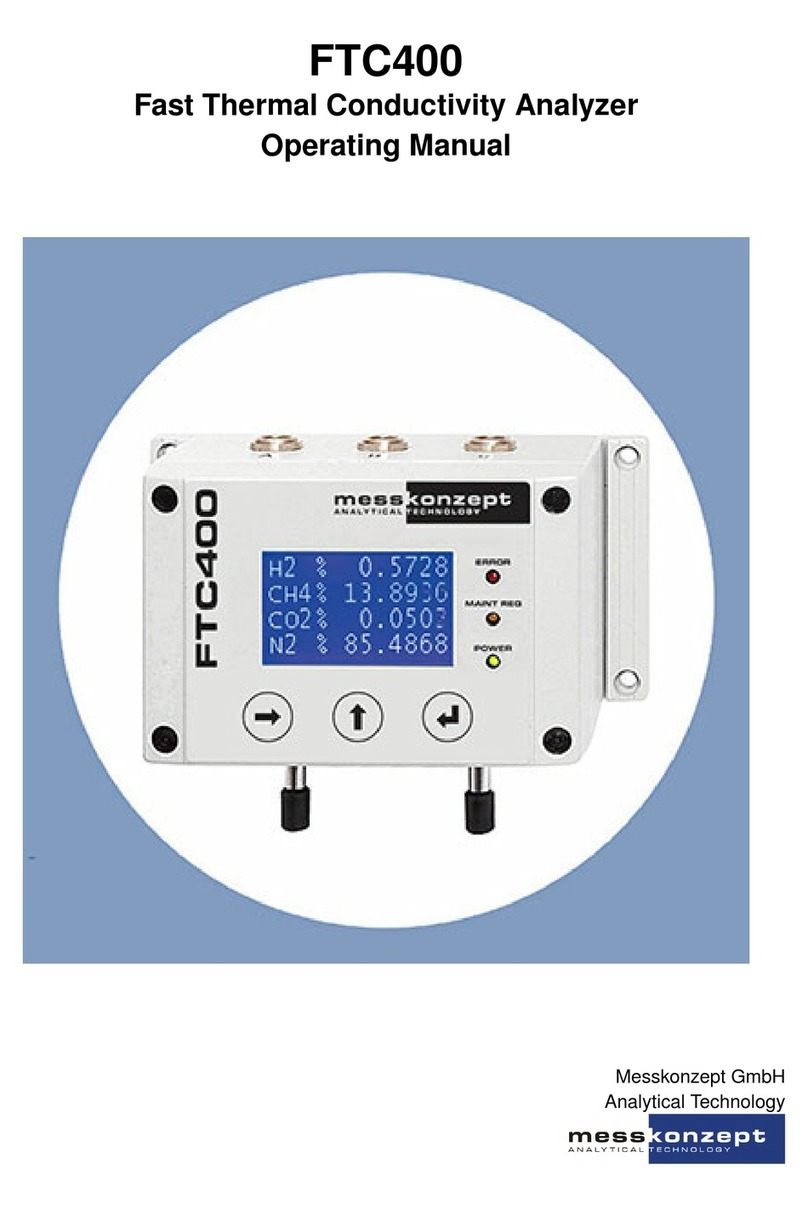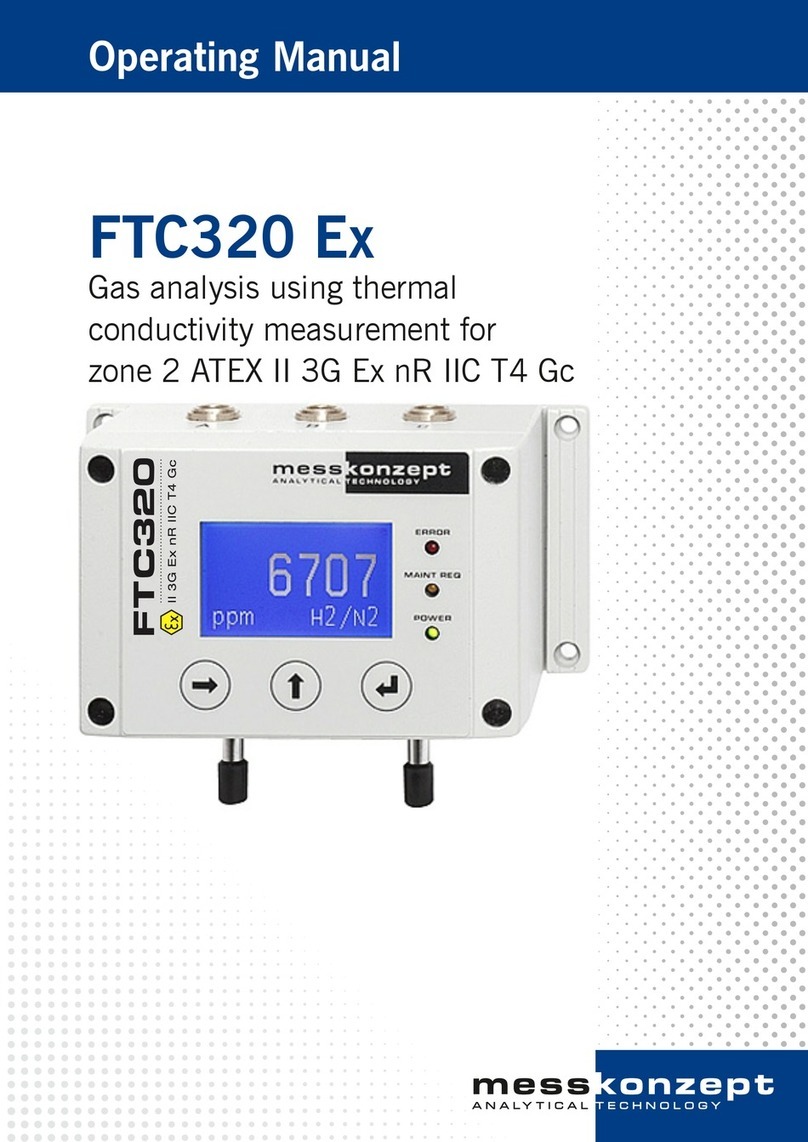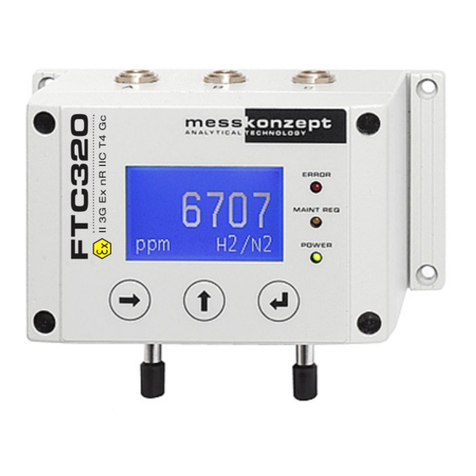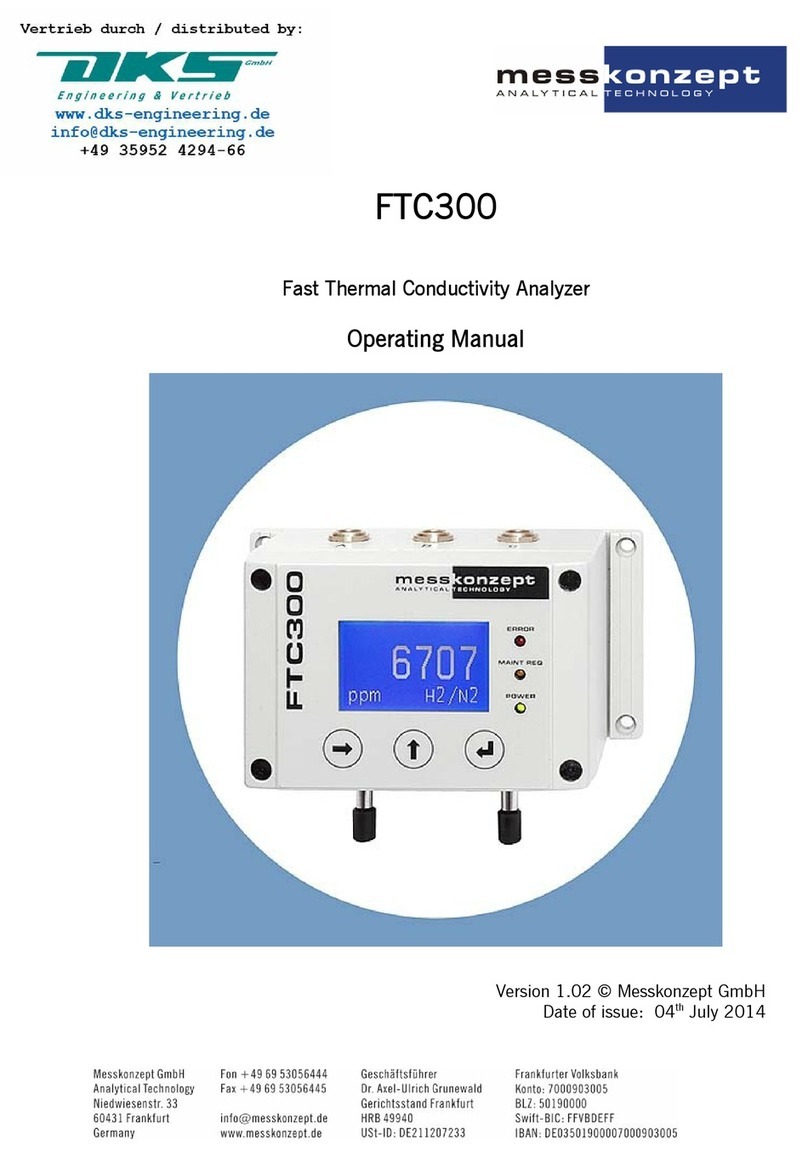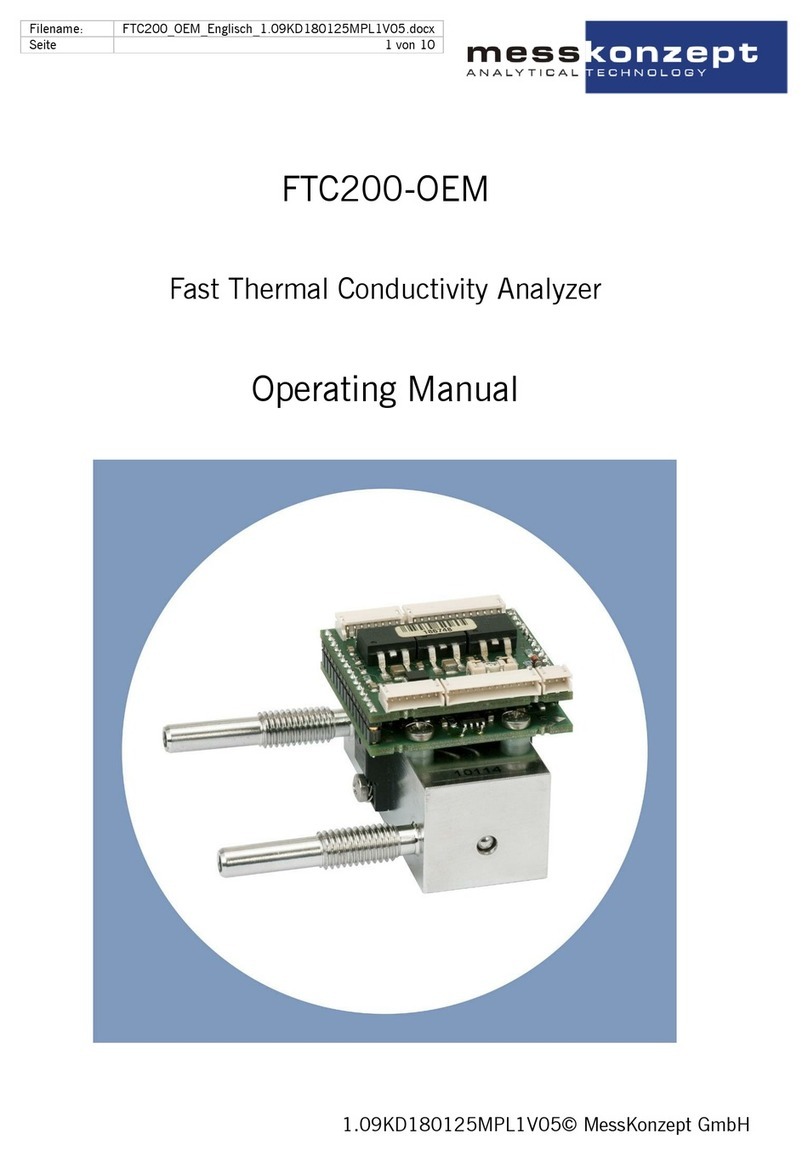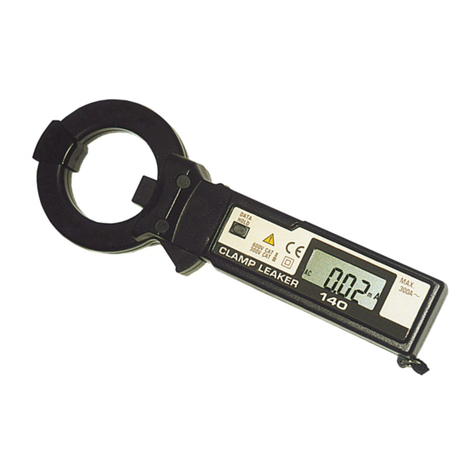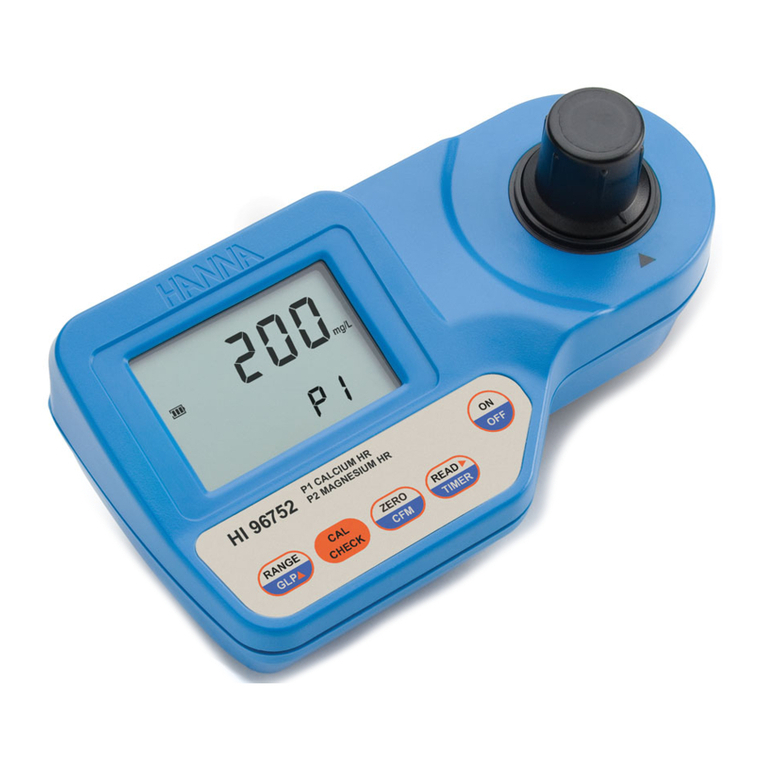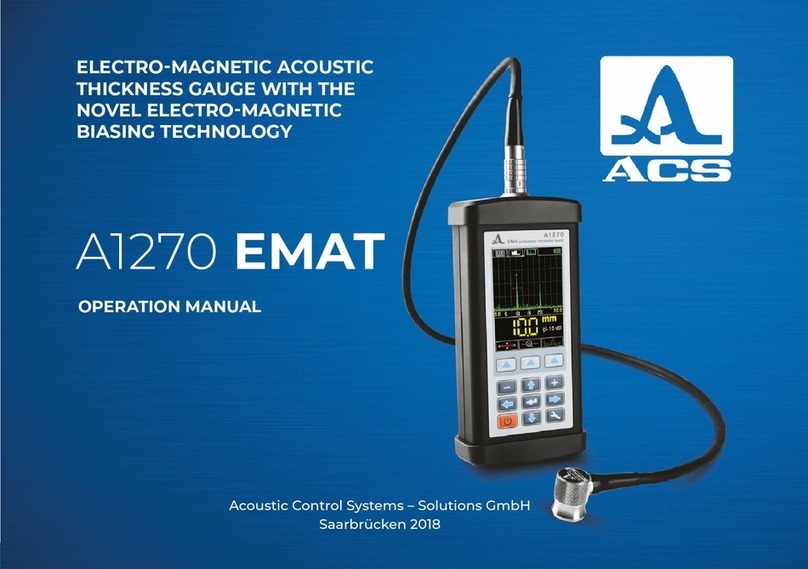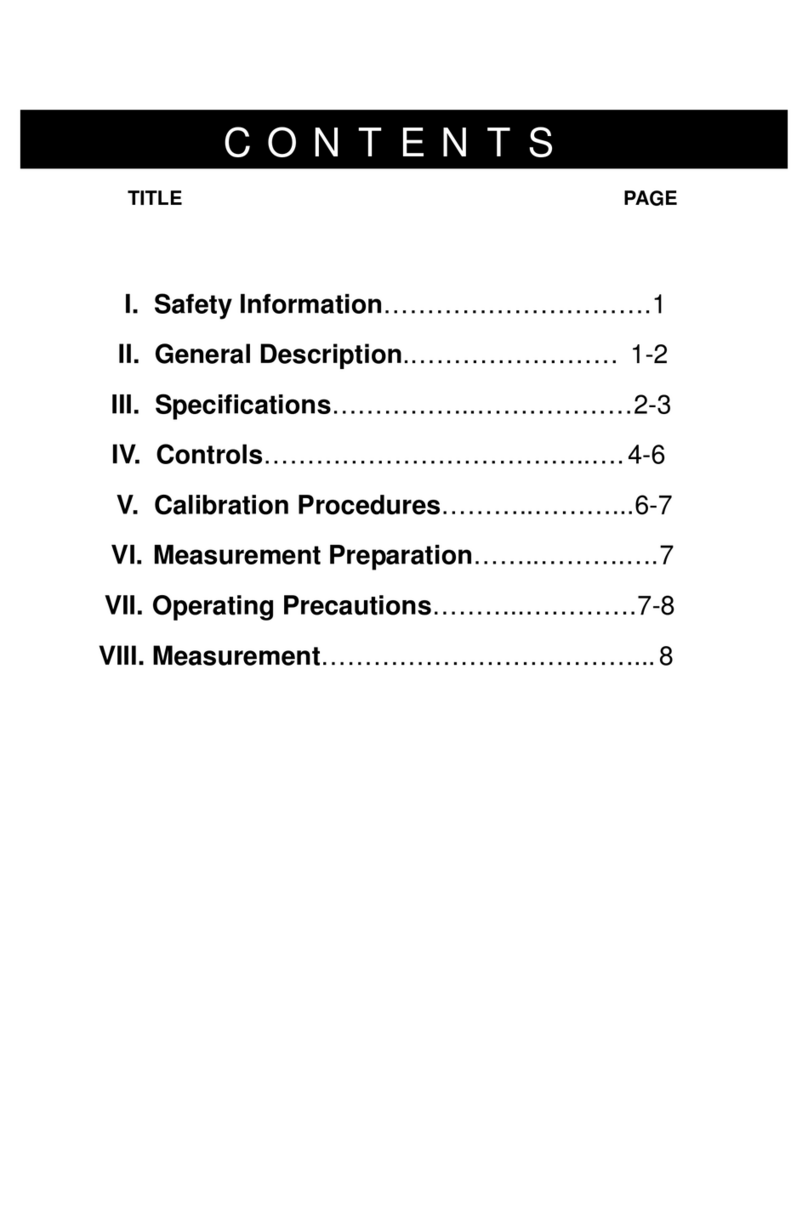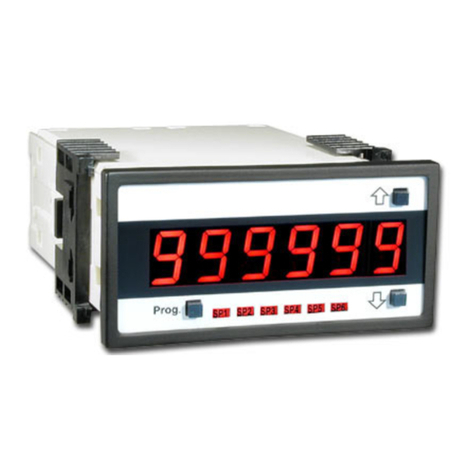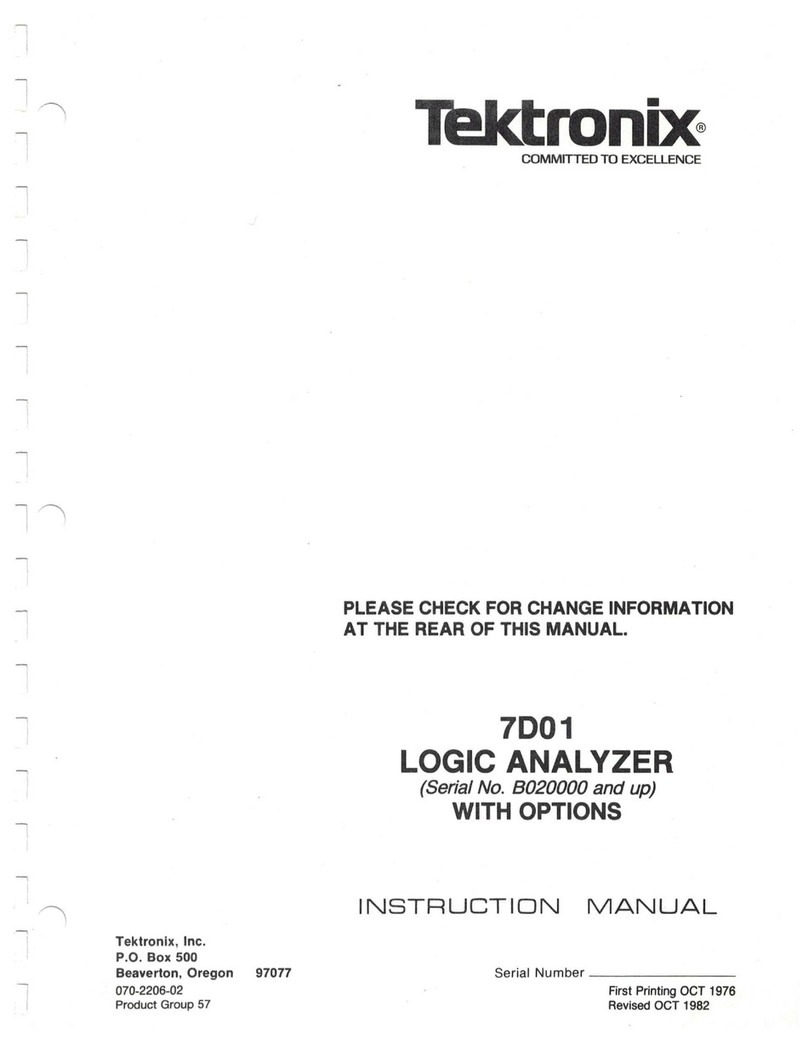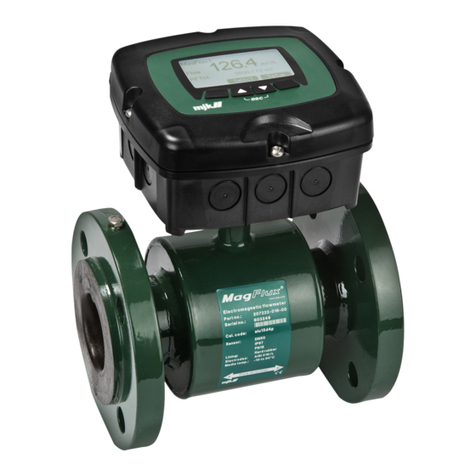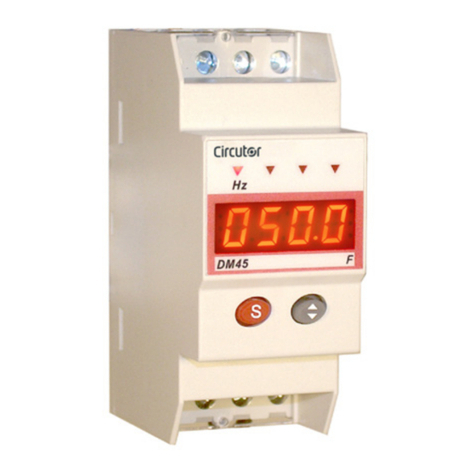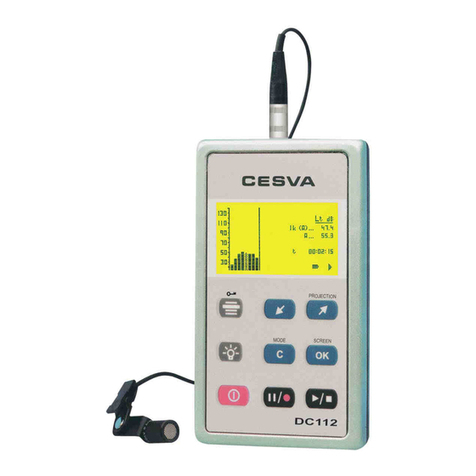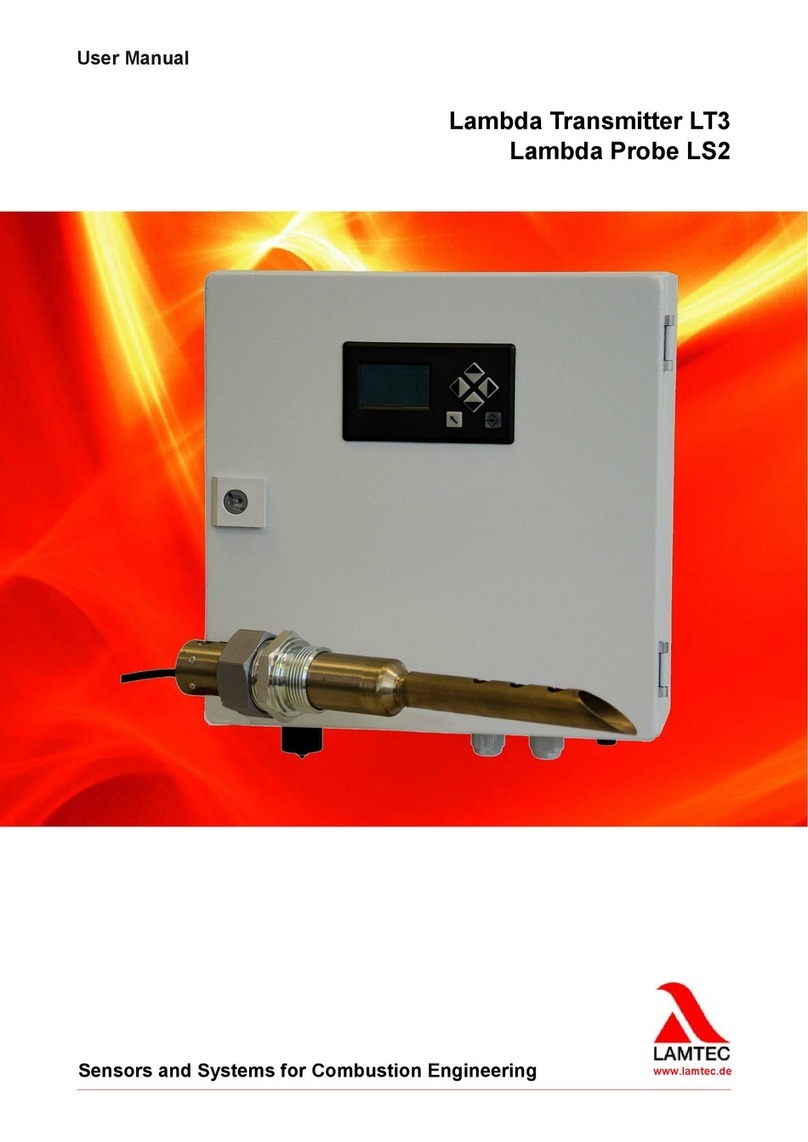MessKonzept FTC320 User manual

FTC320
Gas analysis using thermal
conductivity measurement
Operating Manual

Page 1 of 41
About this manual
Thank you for using the Messkonzept FTC320. It has been designed and manufactured using highest
quality standards to give you trouble free and accurate measurements.
© Copyright Messkonzept GmbH 2020.
This document is protected by copyright. Neither the whole nor any part of it or the information
contained in it may be adapted or reproduced in any form except with the prior written approval of
Messkonzept.
All information of technical nature and particulars of the product and its use (including the information
in this manual) are given by Messkonzept in good faith. However, it is acknowledged that there may be
errors or omissions in this manual. Images and drawings may not be in scale. For the latest revisions
to this manual contact Messkonzept or visit www.messkonzept.de
Messkonzept welcomes comments and suggestions relating to the product and this manual.
Please Note! The design of this instrument is subject to continuous development and improvement.
Consequently, this instrument may incorporate minor changes in detail from information contained in
this manual.
Important! In correspondence concerning this instrument, please specify the type number and serial
number as given on the type label on the right side of the instrument.
All correspondence should be addressed to:
Messkonzept GmbH
Niedwiesenstr. 33
60431 Frankfurt
Germany
Tel: +49(0)69 53056444
Fax: +49(0) 69 53056445
email: info@messkonzept.de
http: www.messkonzept.de
This manual applies to: FTC320
Date of Release: March 11, 2021
File name:
FTC320 Operating Manual_1.09KD201009MPO5V02.pdf

Page 2 of 41
Quick Installation Guide
For quick installation of the FTC320 we recommend to read the following chapters of this manual:
• Chapter 1 "Operator Safety": Important warnings, saftey instructions and intended use.
• Chapter 3 "Assembly of the Instrument": Mounting, pneumatic and electric connection. Also see
Chapter 10 "Appendix: Dimensional Drawing"
• Section 7.1 "Calibration": Recommended calibration intervals, the calibration process and rec-
ommended test of functionallity after bringing into service.
File name:
FTC320 Operating Manual_1.09KD201009MPO5V02.pdf

Page 3 of 41
Contents
1 Operator Safety 5
1.1 Notes on Safety Conventions and Icons . . . . . . . . . . . . . . . . . . . . . . . . . . . 5
1.2 Warning Notices . . . . . . . . . . . . . . . . . . . . . . . . . . . . . . . . . . . . . . . . 6
1.3 Safety Instructions . . . . . . . . . . . . . . . . . . . . . . . . . . . . . . . . . . . . . . . 7
1.4 Intended Use . . . . . . . . . . . . . . . . . . . . . . . . . . . . . . . . . . . . . . . . . 7
2 Principle of Measurement 8
2.1 Determining Concentrations via Thermal Conductivity . . . . . . . . . . . . . . . . . . . 8
2.2 FTC320 Detector Unit . . . . . . . . . . . . . . . . . . . . . . . . . . . . . . . . . . . . . 11
3 Assembly of the Instrument 12
3.1 Installation of the FTC320 . . . . . . . . . . . . . . . . . . . . . . . . . . . . . . . . . . . 12
3.2 GasPorts ........................................... 13
3.3 Electrical Connectors and Ground . . . . . . . . . . . . . . . . . . . . . . . . . . . . . . 13
3.3.1 Requirements for Electrical Connectors . . . . . . . . . . . . . . . . . . . . . . . 15
3.3.2 Ground......................................... 15
3.3.3 Data exchange via serial interface (RS-232) . . . . . . . . . . . . . . . . . . . . . 15
4 The Front Panel 17
4.1 Display............................................. 18
4.2 Keys .............................................. 18
5 Instrument display 19
5.1 Warm up Screen . . . . . . . . . . . . . . . . . . . . . . . . . . . . . . . . . . . . . . . 19
5.2 Operation Screen . . . . . . . . . . . . . . . . . . . . . . . . . . . . . . . . . . . . . . . 19
5.2.1 Display of one measured value . . . . . . . . . . . . . . . . . . . . . . . . . . . . 20
5.2.2 Display of several measured values . . . . . . . . . . . . . . . . . . . . . . . . . 20
6 General instrument settings 21
6.1 Top Level Main Menu . . . . . . . . . . . . . . . . . . . . . . . . . . . . . . . . . . . . . 21
6.2 Diagnosis ........................................... 21
6.2.1 Parameter Menu . . . . . . . . . . . . . . . . . . . . . . . . . . . . . . . . . . . . 22
6.2.2 Errors ......................................... 22
6.3 Instrument Setup . . . . . . . . . . . . . . . . . . . . . . . . . . . . . . . . . . . . . . . 23
6.3.1 Display Unit . . . . . . . . . . . . . . . . . . . . . . . . . . . . . . . . . . . . . . 23
6.3.2 Response Time Setup . . . . . . . . . . . . . . . . . . . . . . . . . . . . . . . . 23
6.4 Output Setup . . . . . . . . . . . . . . . . . . . . . . . . . . . . . . . . . . . . . . . . . 24
6.5 Expert Setup . . . . . . . . . . . . . . . . . . . . . . . . . . . . . . . . . . . . . . . . . . 24
6.5.1 Parameter . . . . . . . . . . . . . . . . . . . . . . . . . . . . . . . . . . . . . . . 25
File name:
FTC320 Operating Manual_1.09KD201009MPO5V02.pdf

Page 4 of 41
6.5.2 Access Modes . . . . . . . . . . . . . . . . . . . . . . . . . . . . . . . . . . . . . 26
6.5.3 Reset Functions . . . . . . . . . . . . . . . . . . . . . . . . . . . . . . . . . . . . 26
6.5.4 Test of Relays, Analog Outputs and Connections . . . . . . . . . . . . . . . . . . 27
7 Measurand related settings 29
7.1 Calibration . . . . . . . . . . . . . . . . . . . . . . . . . . . . . . . . . . . . . . . . . . . 29
7.1.1 Set Offset Gas Concentration . . . . . . . . . . . . . . . . . . . . . . . . . . . . . 31
7.1.2 Set Gain Gas Concentration . . . . . . . . . . . . . . . . . . . . . . . . . . . . . 31
7.1.3 Offset Calibration . . . . . . . . . . . . . . . . . . . . . . . . . . . . . . . . . . . 31
7.1.4 Gain Calibration . . . . . . . . . . . . . . . . . . . . . . . . . . . . . . . . . . . . 32
7.2 AlarmSetup.......................................... 32
7.2.1 Selection of alarm groups . . . . . . . . . . . . . . . . . . . . . . . . . . . . . . . 33
8 Appendix: System Errors 34
9 Appendix: Specifications 37
9.1 Specification of Thermal Conductivity Measurement . . . . . . . . . . . . . . . . . . . . 37
9.2 Electrical Specifications . . . . . . . . . . . . . . . . . . . . . . . . . . . . . . . . . . . . 38
9.3 Permissible Conditions of the sample to be measured . . . . . . . . . . . . . . . . . . . 39
9.4 Environmental conditions . . . . . . . . . . . . . . . . . . . . . . . . . . . . . . . . . . . 39
9.5 Dimensions .......................................... 39
10 Appendix: Dimensional Drawing 40
File name:
FTC320 Operating Manual_1.09KD201009MPO5V02.pdf

Page 5 of 41
Chapter 1
Operator Safety
This chapter provides information and warnings which must be followed to ensure safe operation and
retain the instrument in safe condition. Read this section carefully before beginning to install and use
the instrument.
1.1 Notes on Safety Conventions and Icons
This icon draws attention to application errors or actions that can lead to safety risks
including the injury to persons or malfunctions, possibly even destruction of the device.
This icon indicates an additional function or hint.
File name:
FTC320 Operating Manual_1.09KD201009MPO5V02.pdf

Page 6 of 41
1.2 Warning Notices
• The manufacturer does not assume liability for inappropriate handling of the device. Malfunctions
caused by inappropriate handling may lead to hazards.
• This device is not suited for the operation in areas exposed to explosion hazards!
• Never lead explosive gases or gas mixtures into the device!
• Dependent on the model the device flammable gases may be led in the device. Check item „Glass
ball filling“ in the device protocol. Flammable gases may be led in devices filled with glass balls.
Here, the inside space of the housing is densely filled with glass balls (
∼0.6mm). In the unlikely
case that a leakage caused an explosive atmosphere, the small spaces between the glass balls
prevent a coincidental ignition caused by a further malfunction of the device from propagating.
• Never open the housing of the FTC320, especially because of the loose glass balls. When the
device had been opened it may not work safely with flammable gases.
• Warranty expires if the housing is opened.
• The unit and the cables must be effectively protected against damage and against UV light (pro-
tective roof for outdoor installation).
File name:
FTC320 Operating Manual_1.09KD201009MPO5V02.pdf

Page 7 of 41
1.3 Safety Instructions
• For safe operation of the device please pay regard to all instructions and warnings in this manual
• Only put the device into operation after it has been installed properly. A competent and authorised
person is required for installation, connection and operation of the device. This person has to read
the manual and follow all instructions. Keep this manual to look up questions that can occur later
on.
• Defective devices must be disconnected from the process! This applies for apparent damages
of the device such as physical damages but also in the case of unclarified malfunctions in the
operation. Separate the device from the process pneumatically (both gas inlet and gas outlet)
and remove the power supply from the device.
• Make sure that the electric installation protection against accidental contact agree to the applica-
ble safety regulations. The protective earth connection must be made before all other connec-
tions. Any interruption in the protective earth can cause danger.
• Pay regard to the local regulations and circumstances regarding electric installations.
• Repairs may only be done by Messkonzept.
1.4 Intended Use
Only gases that are non-corrosive and free of condensate, dust, aerosol or oil mist may be lead in the
FTC-series gas analyzer. Flammable gases require appropriate protective measures. Explosive gases
may not be lead into the FTC. The Instrument may not be used in hazardous areas. Please contact
info@messkonzept.de for detailed information and solutions.
Upon installation the protection class has to be considered. The ambient atmosphere may not be cor-
rosive. OEM-devices with protection class IP00 demand thermal and electric insulation, as well as
mechanical protection for operation.
FTC-series gas analyzers do not have a metrology marking in the sense of EU directive 2014/32/EU.
They may therefore not be used for example in analyzes in medical and pharmaceutical laboratories or
in the manufacture of pharmaceuticals in pharmacies based on a doctor’s prescription.
The specifications of the device and its manual have to be observed strictly. Please fill out questionnaire
(2.01.1FB180619MPL1) for registration of your measuring task, if your intended use does not comply
with intended use described above. Based on the information given in the questionnaire Messkonzept
will examine the measuring task and possibly authorize it.
Note: Please keep this manual for future use.
File name:
FTC320 Operating Manual_1.09KD201009MPO5V02.pdf

Page 8 of 41
Chapter 2
Principle of Measurement
2.1 Determining Concentrations via Thermal Conductivity
Thermal Conductivity Detectors (TCD) are used in the chemical industry since the 1920s as the first
process gas analyzers for the quantitative composition of gas mixtures. Every gas has a typical heat
conductivity governed by its molar mass and viscosity. The measurement is based on the principle that
the thermal conductivity of a gas mixture is dependent on the thermal conductivities of its gas compo-
nents and their fractional amounts in the mixture. Thus, the concentrations of different components can
be calculated from the thermal conductivity.
The main advantage of the TCD’s measurement principle compared with the wide spread infrared
analysis technique is, that it is not limited to gases with a permanent dipole moment. It can identify
noble gases (He, Ar, Ne, etc.) as well as homonuclear gases such as H2and N2. Furthermore, it is
robust and cost effective.
The principle of thermal conductivity measurement works best if the analyzed gas components’ thermal
conductivities vary greatly. For TC measurement based analysis, one of the following conditions must
be met:
• The mixture contains only two different gases (binary mixture), e.g. CO2in N2or H2in N2
• The thermal conductivity of two or more components is similar, e.g. measuring H2or He in a
mixture of O2and N2(quasi binary mixture)
• The mixture contains more than two gases, but all but two components’ (or component groups’)
volumetric fractions are constant over time
• The mixture contains more than two gases, of which all but two components’ concentrations
can be determined through other measurement principles (as employed in the FTC 400 through
cross-sensitivity compensation of IR- and TC-sensor information)
The thermal conductivity of gases rises with temperature and the slope of the increase
with temperature is different for different gases. On customer request it can be checked
whether the temperature of heat sink and/or source can be changed in order to improve
the sensitivity of the measurement or to avoid cross-sensitivity effects.
Cross-sensitivity is the sensitivity of the measurement on other gases than the measured
component. Perturbation-sensitivity means the sensitivity of the measurement on other
influences than the gas-composition, e.g. the gas pressure.
File name:
FTC320 Operating Manual_1.09KD201009MPO5V02.pdf

Page 9 of 41
Gas Out
130˚C
60˚C
Gas In
Figure 2.1: Schematic drawing of thermal conductivity measurement. The sensor is comprised in the
stainless steel block which is kept at a constant temperature.
The FTC320 contains a thermal conductivity sensor to analyze the quantitative composition of gas mix-
tures. The measurement is based on the heat transfer between a heat source and a heat sink.
The measuring gas is led through a stainless steel block that is kept at a constant temperature of
63◦C (for most applications). The block temperature is stabilized using a control loop - it serves as
a heat sink of constant temperature. A micro mechanically manufactured membrane with a thin-film
resistor serves as heat source. A control loop stabilizes the membrane temperature at 135◦C (for most
applications).
Above and below the membrane two small cavities are etched into the silicon. These cavites are filled
with measuring gas by diffusion. The surfaces opposite to the membrane are thermally connected with
the heat sink. Through maintaining a constant temperature gradient between the two opposite surfaces,
the heat flow is dependant of the gas mixture’s thermal conductivity alone. Hence the voltage needed
to keep the membrane temperature constant is a reliable measure for the thermal conductivity of the
mixture and can be used further to determine the gas mixture’s composition.
File name:
FTC320 Operating Manual_1.09KD201009MPO5V02.pdf

Page 10 of 41
Mea-
suring
Gas
Carrier
Gas
Basic
range Smallest range
Smallest
supressed zero
range
Multi Gas
Mode
H2N2/ air 0% - 100% 0% - 0.5% 98% - 100% Yes
H2Ar 0% - 100% 0% - 0.4% 99% - 100% Yes
H2He 20% - 100% 20% - 40% 85% - 100% On
request
H2CH40% - 100% 0% - 0.5% 98% - 100% On
request
H2CO20% - 100% 0% - 0.5% 98% - 100% On
request
He N2/ air 0% - 100% 0% - 0.8% 97% - 100% Yes
He Ar 0% - 100% 0% - 0.5% 98% - 100% Yes
CO2N2/ air 0% - 100% 0% - 3% 96% - 100% Yes
CO2Ar 0% - 60% 0% - 10% - Yes
Ar N2/ air 0% - 100% 0% - 3% 96% - 100% Yes
Ar CO240% - 100% - 80% - 100% Yes
CH4N2/ air 0% - 100% 0% - 2% 96% - 100% Yes
CH4Ar 0% - 100% 0% - 1.5% 97% - 100% Yes
O2N20% - 100% 0% - 15% 85% - 100% Yes
O2Ar 0% - 100% 0% - 2% 97% - 100% Yes
N2Ar 0% - 100% 0% - 3% 97% - 100% Yes
N2CO20% - 100% 0% - 4% 96% - 100% On
request
NH3H20% - 100% 0% - 5% 95% - 100% On
request
CO2H20% - 100% 0% - 2% 99% - 100% On
request
SF6N2/ air 0% - 100% 0% - 2% 96% - 100% On
request
Table 2.1: Measuring ranges of typical gas compositions for analysis with the FTC320.
The FTC320 must not be used with explosive gases. Flammable gases such as H2and
CH4may only be used in devices filled with glass balls. A gas mixture of a flammable
gas with an inert gas in a mixing ratio such, that it is still inflammable for any amount of
air added is called totally inertised. Totally inertised gases can also be used in devices
without glass balls.
File name:
FTC320 Operating Manual_1.09KD201009MPO5V02.pdf

Page 11 of 41
“Basic range“ is the largest possible measuring range and is set by default. The lineariza-
tion is performed over the basic range. The smallest measuring ranges at the beginning
and the end of the basic range are facilitated through specific calibration. The smallest
possible range between the basic range and the smallest ranges at the end beginning and
the end of the range can be estimated by linear Interpolation.
The Multi Gas Mode (MGM) is a configuration that allows for the consecutive mea-
surement of different gas pairs. The gas pair can be switched through the control panel
or via the RS232-interface. Gas pairs labeled “Yes“ in Table 2.1 are commonly used. Gas
mixtures labelled “On request“ can also be implemented upon request.
2.2 FTC320 Detector Unit
The FTC320 detector unit consists of a hermetically sealed pressure proof stainless steel block with
a gas duct, which is suited for pressures up to 20 bar. Sample gas entering through the gas inlet is
guided to the micro-mechanical thermal conductivity sensor and further downstream to the outlet port.
In particular the pneumatics are designed to minimize the influence of a changing gas flow. The oper-
ating temperature of 63◦C is stabilized by a highly accurate PI control loop.
In order to avoid electrical interference on the measuring output the high performance analog adap-
tion circuit is directly mounted on top of the stainless steel block. The piggyback-mounted processor
board digitizes the signal in a 24bit A/D converter. The micro-controller performs all calculations, as
linearization, calibrations and cross sensitivity compensation directly on the detector unit.
File name:
FTC320 Operating Manual_1.09KD201009MPO5V02.pdf

Page 12 of 41
Chapter 3
Assembly of the Instrument
3.1 Installation of the FTC320
The FTC320 is designed for wall fastening. The four mounting holes are shown in Figure 3.1. M4
cylinder head bolts are suitable. Please remember to keep additional space for adequate assembly of
gas hoses and cables (see Chapter 10 "Appendix: Dimensional Drawing" for more information).
6mm
52 mm
20 mm
26 mm
80 mm
65 mm
144 mm
132 mm 4.5mm
Figure 3.1: Mounting holes shown from the reverse side of the housing
If you are planning to lead flammable or toxic gases into the device, the device must be
installed in a well ventilated area. All devices undergo a leakage test during production,
nevertheless a limited release of small gas quantities is possible.
File name:
FTC320 Operating Manual_1.09KD201009MPO5V02.pdf

Page 13 of 41
3.2 Gas Ports
On the bottom of the FTC320 housing two tubes with 6mm outer diameter for gas connection are lo-
cated. They are labeled with “GAS IN “ and “GAS OUT“.
For low requirements regarding gas tightness and resistance to pressure the tubes can be used as
hose connector. For permanent gas and pressure tightness compression fittings are recommended
(e.g. by “Swagelok“©).
After connecting the device a leakage test should be performed (especially when working with flammable
and/or toxic gases).
3.3 Electrical Connectors and Ground
1: Analog Input 1
2: Analog Output 2
3: Analog Reference
4: Digital Input (24V)
5: Ground pin 4
6: Analog Output 1
7: Analog Input 2
1: 0 (4) - 20mA,
isolated +
2: 0 (4) - 20mA,
isolated -
3: Ground
RS232
4: TxD
5: RxD 1: Relay 1 - A
2: Power Supply-GND
4: Power supply +24V
3: Relay 1 - B
7: Relay 3 - A
6: Relay 2 - B
5: Relay 2 - A
8: Relay 3 - B
AB C
Figure 3.2: Electrical connector pin assignments of the three connectors on the FTC320
The FTC320 has three three plug connectors as shown in Figure 3.2. Further information on the func-
tion of each contact is given in Table 3.1. The cables (712, IP67) with molded connector plug and a
length of two meters (five meters available on request) are part of the purchased parts package. The
cables have open ends. The cross-section of the conductors in cable A and C is 0,14mm2, for cable B
0,25mm2. Cable A is shipped with devices set up for analog output.
The protection class of the device is only effective with all cables attached. In case cable
A is not used, connector plug A has to be closed with an end fitting.
File name:
FTC320 Operating Manual_1.09KD201009MPO5V02.pdf

Page 14 of 41
Pin No. Wire
colour Function Description
Connector
A
(7 pins)
1 white Analog Input 1 0 to 10V, 24 bit resolution
2 brown Analog Output 2 0 to 10V, 16 bit resolution
3 green GND GND for pins 1, 2, 6, 7
4 yellow Digital Input (DIN) low: <4.6V; high: >11.4V
5 grey GND GND for Pin 4
6 pink Analog Output 1 0 to 10V, 16 bit resolution
7 blue Analog Input 2 0 to 10V, 24 bit resolution
Connector
B
(5 pins)
1 white Current Loop +
0 (4) to 20mA, floating
isolated ±500V to ground,
max. 1000 Ohm burden
16 bit resolution
2 brown Current Loop -
3 black Serial Interface RS232 GND for pin 4, 5
4 blue Serial Interface RS232 TxD (transmit data)
5 grey Serial Interface RS232 RxD (receive data)
Connector
C
(8 pins)
1 white Relay 1 isolated contact; max 30V, 0.5A
2 brown Power supply - GND
3 green Relay 1 isolated contact; max. 30V, 0.5A
4 yellow Power supply + + 24V (18V to 30V), max. 700mA
5 grey Relay 2 isolated contact; max. 30V, 0.5A
6 pink Relay 2 isolated contact; max. 30V, 0.5A
7 blue Common Relay 3 isolated contact; max. 30V, 0.5A
8 red Common Relay 3 isolated contact; max. 30V, 0.5A
Table 3.1: Connecting pin assignment of connectors A, B, C
File name:
FTC320 Operating Manual_1.09KD201009MPO5V02.pdf

Page 15 of 41
3.3.1 Requirements for Electrical Connectors
Before using the device make sure that the power supply is in accordance with the
specifications of the device and that all electric connections correspond to the information
given in this manual.
The FTC320 is a device of protection class III. For power supply a source with PELV specification (Pro-
tective Extra Low Voltage) according to EN 60204-1 must be used. See also Section 3.3.2 "Ground".
The potential-free relay contacts must also be monitored with a power supply unit with PELV specifica-
tion.
3.3.2 Ground
ERROR
MAINT REQ
POWER
power supply
PELV complying
with EN 60204-1
+24V GND
AB C
GAS OUT GAS IN
Figure 3.3: Grounding the FTC320
To comply with EN 60204-1 and to ensure your device’s function, the device has to be installed such
that the power supply (PELV) is connected to protective earth (PE) with its ground conductor, see
Figure 3.3. The shielding of cables A, B and C should be connected to functional ground. Dependent
on the circumstances, gas inlet and gas outlet can be grounded in addition. Connections to ground
should be made with short low-resistant cables of large diameter.
3.3.3 Data exchange via serial interface (RS-232)
The serial interface, often called UART (Universal Asynchronous Receiver Transmitter), is based on the
RS-232 standard. The point-to-point data transmission is carried out via the two TxD- (Transmit Data)
File name:
FTC320 Operating Manual_1.09KD201009MPO5V02.pdf

Page 16 of 41
and RxD- (Receive Data) wires to be crossed with a common ground line (GND) for both devices. This
creates a bidirectional bus that allows full-duplex communication. The communication partners can
therefore send and receive data simultaneously.
Data transmission via UART is performed with a fixed data frame (UART frame). This frame must be
known to both communication partners. It consists of: A start bit, 5-9 data bits, an optional parity bit and
one or two stop bits. If a PC is connected to the analyzer, the necessary settings are typically identified
automatically. If this is not the case, the parameters can be set manually according to Table 9.2. (see
Section 9.1).
Only a few PCs are still delivered with a so-called COM port (serial RS-232 interface). In order to be
able to operate and program devices that have an RS-232 interface with computers without this, use
of converters from RS232 to USB is advised. The converters often have a 9-pin D-Sub connector as
input, but there are also converters with screw terminal connections.
The serial interface allows operation of the instrument and the display and storage of
measurement data with the SetApp program. More information and a link to download the
software can be found at www.messkonzept.de.
If you plan to develop or use your own software solutions for communication via the
RS-232 interface, you may need more detailed information on the available parameters,
etc. Please contact Messkonzept in this regard.
File name:
FTC320 Operating Manual_1.09KD201009MPO5V02.pdf

Page 17 of 41
Chapter 4
The Front Panel
A1 A2 Er
0.30
[%] H2/N2
ERROR
MAINT REQ
POWER
Process Alarm 2 Indicator
Process Alarm 1 Indicator
Error Indicator
Maintenance Indicator
Operation Indicator
Currently measured
gas concentration
Measurement Unit
[Vol%] or [ppm]
RIGHT / Selection Key
(Toggle MGM Mode) UP / Selection Key ENTER / Terminate Key
(Gas Selection in MGM-Mode)
Figure 4.1: Front view schematic of the FTC320 front panel
File name:
FTC320 Operating Manual_1.09KD201009MPO5V02.pdf

Page 18 of 41
4.1 Display
4.2 Keys
RIGHT / Selection Key
On the operation screen, the <RIGHT> key can be used to select one of the measured
variables displayed on the work screen. With the <ENTER> key the menu related to the
measured parameter can be called up, in which, for example, the calibration routine of the
parameter can be accessed.
The <RIGHT> key enables the operator to scroll through the various menu items of menus
and submenus. The currently selected menu item is marked by black background and is
called with the <ENTER> key.
In submenus requiring numerical inputs, the <RIGHT> key scrolls to the next digit and to
“ESC/OK“ at the end.
UP / Selection Key
In menus or submenus the <UP> key quits the recent menu and bring you back to the
menu above and ultimately to the main menu.
To quit menus with an “ESC/OK“ option, select one of these fields with the <RIGHT> key
and confirm with <ENTER>.
In submenus requiring numerical inputs, the <UP> key changes the selected digit.
ENTER / Termination Key
The <ENTER> key calls the item that is marked as selected (selection is indicated through
black background highlighted text). Menu items are selected by the <RIGHT> key. In sub-
menus with an “ESC/OK“ option the <ENTER> key confirms the selection of “ESC“ or “OK“.
File name:
FTC320 Operating Manual_1.09KD201009MPO5V02.pdf

Page 19 of 41
Chapter 5
Instrument display
This chapter describes the device start-up routine. The warm up screen, see Figure 5.1, shows the
block temperature while the block warms up. After the warm up, the device switches to the operation
screen, see Figure 5.2. From the operation screen the main menu can be opened.
Note: To make device-specific settings on the device, it is necessary to enter an Expert code (preset to
222.0000).
5.1 Warm up Screen
Warm Up
Set: 63.00 °C
Act: 58.30 °C
Figure 5.1: warm up screen of the FTC320
The warm up screen shows the current block temperature during warm up in the center of the screen
(see Figure above). The target value of the block temperature, 63 ◦C for the standard version or 70 ◦C
for the high temperature version, is shown in the bottom line of the screen.
Pressing the <UP> key during warm up switches directly to operation screen and activates
the current loop. The displayed concentration value will not be precise until the needed
block temperature is reached.
5.2 Operation Screen
After warm up the operation screen is shown (see Figure above). Depending on the version of the
instrument, either one measured value or several measured values are displayed on the working screen.
From the operational screen the main menu can be opened using the <UP> key.
File name:
FTC320 Operating Manual_1.09KD201009MPO5V02.pdf
Other manuals for FTC320
1
This manual suits for next models
1
Table of contents
Other MessKonzept Measuring Instrument manuals
Popular Measuring Instrument manuals by other brands
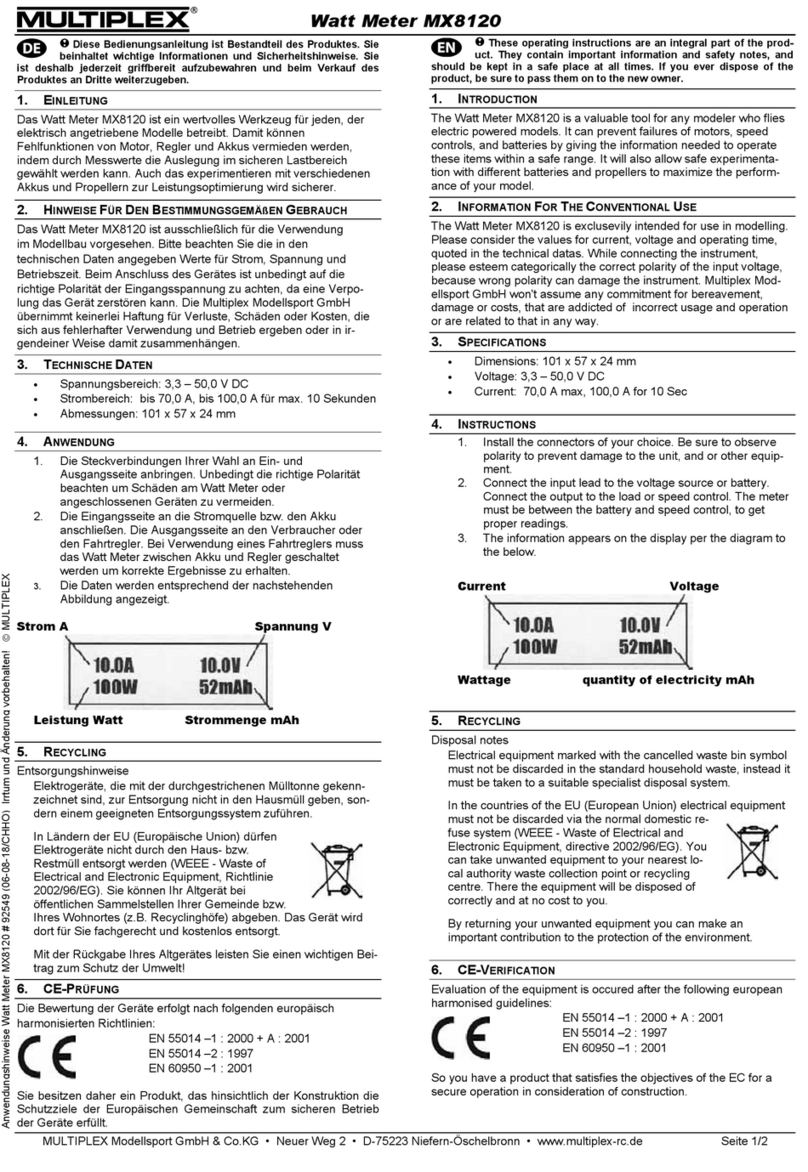
Multiplex
Multiplex MX8120 operating instructions
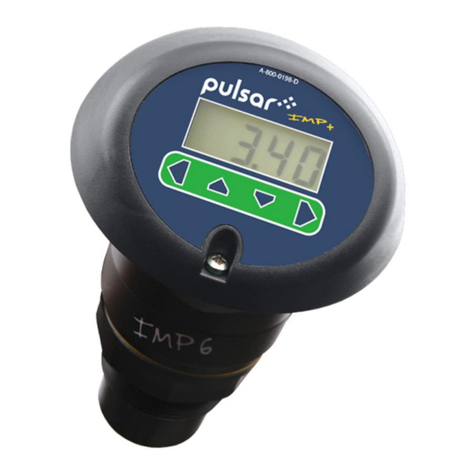
Pulsar Measurement
Pulsar Measurement IMP Lite instruction manual

Heal Force
Heal Force Prince 120 Body Fat Service manual
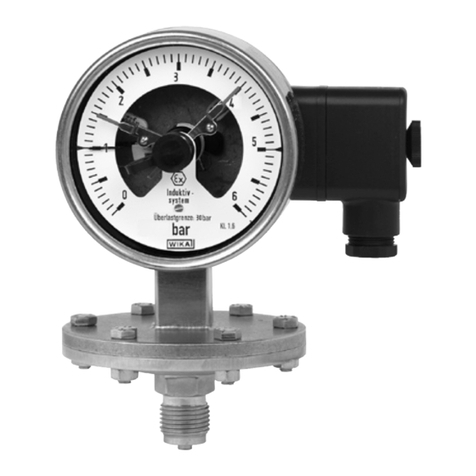
WIKA
WIKA 831 operating instructions
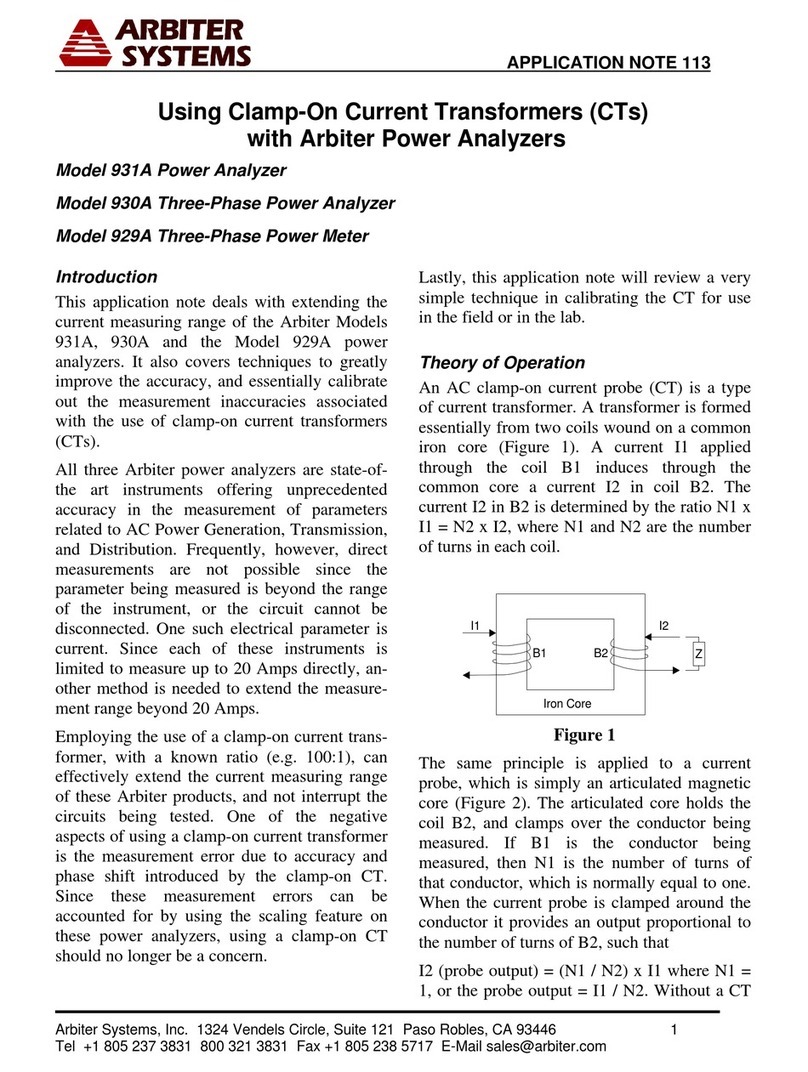
Arbiter Systems
Arbiter Systems 931A Application note

CORNING
CORNING 430 pH Meter instruction manual
